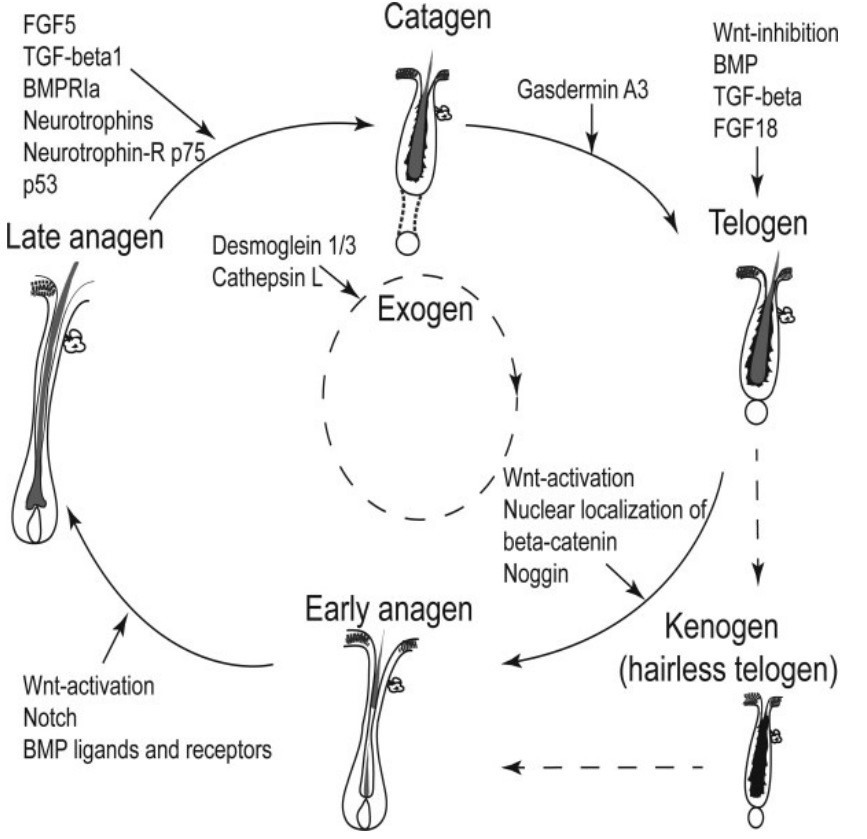The science of natural hair growth cycle
Human hair is produced by a complex and unique organ named hair follicle (1). The hair follicle is a true paradigm of mesenchymal-epithelial interaction and its life cycle is regulated by signalling mechanisms in between mesenchymal and epithelial compartments (2, 3).
The hair follicle is an organ in mammals that constantly transit from active fiber producing form to a resting state (2). In mammals, hair growth is essentials in order to renew and maintain the hair as a protective covering of the body. Therefore, after initial follicular morphogenesis, the hair follicle is continuously maintained through a process called hair growth cycle (4).
Phases of hair growth cycle
The hair growth cycle include periodic stages of anagen (growth phase), catagen (regression phase) and telogen (quiescent phase). After every cycle, anagen followed by catagen and telogen, a new cycle is initiated (4-6). So, once the next cycle occurs, in a process called exogen, the old club hair is shed (7).
The initiation of the exogen phase coincides with the end of telogen, however, the completion occurs when the old club hair has been shed. This process depends on the species and hair type. Therefore the shedding of the hair can happen at any time during the next cycle (4, 8). For instance, in mice, the shedding of their overfur hair occurs in the next anagen, whereas for their underfur hair, it happens either in the subsequent anagen or telogen phase.
Hair length
The length of the hair shaft is dependent on the duration of the hair cycle phases (9). However, the length and duration of the cycle phases is related to various things including the age, gender, hormonal influence, body region, genetic, nutrition, individual health status, environmental factors, neurogenic stimulation, composition of extracellular matrix and drug therapy (4). For instance, the anagen phase in mouse hair follicles as well as human eyebrow hair follicles last for only 2 to 4 weeks. Whereas, in human scalp hair follicle, the anagen lasts for 2 to 6 years (4, 10). On the other hand, the hair follicles stay in catagen for 2 to 3 weeks and the duration of telogen is 3 months on average.
In addition, human hair growth is not synchronised. This means that in different follicles, various phases of cycle can occur simultaneously. Also, in humans around 80% of the scalp hair follicles are in anagen state, where as in poodles it can be up to 98% (4).
How to improve the health of hair growth
There are several ways to improve the overall health of the hair growth. For example using a well-balanced shampoo and powerful hair vitamins are amongst the most important factors.
Schematic diagram illustrating different phases and various factors regulating hair growth cycle (4).
References
1. Bernard BA. The Hair Growth Cycle. Springer International Publishing; 2017. p. 743-7.
2. Bernard BA. Pubmed Central PMCID: 4755418.
3. Sennett R, Rendl M. . 2012 Oct;23(8):917-27.
4. Welle MM, Wiener DJ. Toxicologic pathology. 2016 Jun;44(4)
5. Hsu Y-C, Pasolli HA, Cell.
6. Zhang YV, Cheong J, Ciapurin N, McDermitt DJ, Tumbar T. Cell stem cell. 2009 Sep 4;5(3):267-78
7. Milner Y, Sudnik J, Filippi M, Kizoulis M, Kashgarian M, Stenn K. The Journal of investigative dermatology. 2002 Sep;119(3):639-44.
8. Higgins CA, Westgate GE, Jahoda CA. The Journal of investigative dermatology. 2011 Dec;131(12):2349-57.
9. Westgate GE, Botchkareva NV, Tobin DJ. International journal of cosmetic science. 2013 Aug;35(4):329-36.
10. Duverger O, Morasso MI. Seminars in cell & developmental biology. 2014 Jan-Feb;25-26:22-33.
11. https://www.growgorgeous.co.uk/blog/the-hair-lab/how-does-hair-grow/



